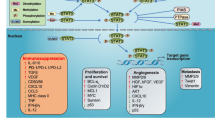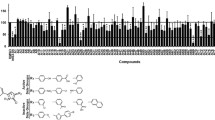Abstract
As an oncogene, over-activated signal transducer and activator of transcription 3 (STAT3) has been detected in many tumors. STAT3 controls cell differentiation, proliferation, and survival, and is associated with angiogenesis and immune dysfunction during tumorigenesis. Double-stranded decoy oligodeoxynucleotide (ODN) targeting over-activated STAT3 in tumor cells have shown significant antitumor efficiency. Here, we describe the materials and methods involved in STAT3 decoy ODN therapy for cancer including both the antitumor effect directly and immunotherapy indirectly.
Access this chapter
Tax calculation will be finalised at checkout
Purchases are for personal use only
Similar content being viewed by others
References
Bowman T, Garcia R, Turkson J et al (2000) STATs in oncogenesis. Oncogene 19:2474–2488
Yu H, Jove R (2004) The STATs of cancer—new molecular targets come of age. Nat Rev Cancer 4:97–105
Bromberg J Jr, Darnell JE (2000) The role of STATs in transcriptional control and their impact on cellular function. Oncogene 19:2648–2673
Zhang X, Zhang J, Wang L et al (2007) Therapeutic effects of STAT3 decoy oligodeoxynucleotide on human lung cancer in xenograft mice. BMC Cancer 7:149
Su Y, Li G, Zhang X et al (2008) JSI-124 inhibits glioblastoma multiforme cell proliferation through G(2)/M cell cycle arrest and apoptosis augment. Cancer Biol Ther 7:1243–1249
Sun X, Zhang J, Wang L et al (2008) Growth inhibition of human hepatocellular carcinoma cells by blocking STAT3 activation with decoy-ODN. Cancer Lett 262:201–213
Kong LY, Gelbard A, Wei J et al (2010) Inhibition of p-STAT3 enhances IFN-alpha efficacy against metastatic melanoma in a murine model. Clin Cancer Res 16:2550–2561
Tkach M, Coria L, Rosemblit C et al (2012) Targeting Stat3 induces senescence in tumor cells and elicits prophylactic and therapeutic immune responses against breast cancer growth mediated by NK cells and CD4+ T cells. J Immunol 189:1162–1172
Bedel R, Thiery-Vuillemin A, Grandclement C et al (2011) Novel role for STAT3 in transcriptional regulation of NK immune cell targeting receptor MICA on cancer cells. Cancer Res 71:1615–1626
Sun X, Sui Q, Zhang C et al (2013) Targeting blockage of STAT3 in HCC cells augments NK cell functions via reverse HCC-induced immune suppression. Mol Cancer Ther 12:2885–2896
Shimizu H, Nakagami H, Tsukamoto I et al (2006) NFkappaB decoy oligodeoxynucleotides ameliorates osteoporosis through inhibition of activation and differentiation of osteoclasts. Gene Ther 13:933–941
Leong PL, Andrews GA, Johnson DE et al (2003) Targeted inhibition of Stat3 with a decoy oligonucleotide abrogates head and neck cancer cell grow. Proc Natl Acad Sci U S A 100:4138–4143
Livak KJ, Schmittgen TD (2001) Analysis of relative gene expression data using real-time quantitative PCR and the 2(-Delta Delta C(T)) Method. Methods 25:402–408
Jiang W, Sun R, Wei H, Tian Z et al (2005) Toll-like receptor 3 ligand attenuates LPS-induced liver injury by down-regulation of toll like receptor 4 expression on macrophages. Proc Natl Acad Sci U S A 102:17077–17082
Acknowledgement
This work was supported by Natural Science Foundation of China (#30628014; #30571696, #81172789, #30972692) and National 973 Science Program by Ministry of Science and Technology of China (2004CB518807).
Author information
Authors and Affiliations
Corresponding author
Editor information
Editors and Affiliations
Rights and permissions
Copyright information
© 2015 Springer Science+Business Media New York
About this protocol
Cite this protocol
Sun, X., Zhang, J. (2015). STAT3 Decoy ODN Therapy for Cancer. In: Walther, W., Stein, U. (eds) Gene Therapy of Solid Cancers. Methods in Molecular Biology, vol 1317. Humana Press, New York, NY. https://doi.org/10.1007/978-1-4939-2727-2_11
Download citation
DOI: https://doi.org/10.1007/978-1-4939-2727-2_11
Publisher Name: Humana Press, New York, NY
Print ISBN: 978-1-4939-2726-5
Online ISBN: 978-1-4939-2727-2
eBook Packages: Springer Protocols




